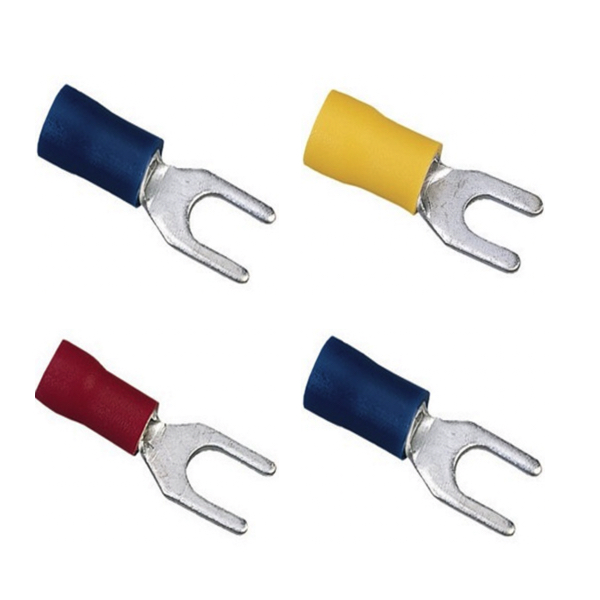
Spade Terminals

Spade terminals, also called fork terminals, are commonly used electrical connectors. They are easy to attach to screws and terminal blocks, and they make a secure and reliable connection when you do. The spade terminal gets its name from the way it looks—a flat, U-shaped fork or paddle. It is wide enough so that you can slip it over the electrical connection point, and it makes a good, tight connection once you're done.
The spade terminal can be installed by stripping the wire and then inserting it into the barrel of the terminal. After this, the crimping tool is used to press the barrel and the wire together to create a connection. Fortunately, the crimping tool is quite good and creates a consistent connection every time. Obviously, this kind of terminus is quite safe in that there are not many ways for it to go wrong. Still, keep in mind that spade connectors are quite safe as long as they are installed in a safe manner, and the safety of terminations is mostly a function of human workmanship.
Products
FAQs
Should I choose tin-plated copper connections for connecting two wires?
Yes, choosing tin-plated copper connections for connecting two wires is a good option because they offer excellent conductivity, corrosion resistance, and durability.
Does a variety of spade terminals help in saving space in a junction box?
Yes, a variety of spade terminals can help save space in a junction box by allowing for organized and efficient connections, ensuring that wires are neatly arranged and easily accessible.
Industrial Wiring Tips and Tricks
Wire Type
MTW is typically used in industrial control panels. The flexibility of the wire allows it to be easily maneuvered through wire ducting. THHN wire is commonly found in homes or commercial buildings. The rigidity of the wire makes it easier to pull through conduit. XHHW wire is similar to THHN but provides a more protective insulation.
Wire Color
The National Electrical Code (NEC) or UL are great points of reference when trying to decide what colors of wire to use. For example, UL standard states that a ground wire should always be green, an AC hot or live wire should be black and AC neutral should be white. These are just a few examples of UL code requirements.
Wire Size
A simple rule of thumb when selecting wire size is, the higher the current, the larger the wire. It is also important to consider the bend radius of the wire. If a wire is bent too sharply, the conductors within the insulation can be damaged.
Wire Connection
It is important to make sure that the wire is connected properly and that enough torque has been applied. If enough torque is not applied to the electrical connection, the wire can become loose over time resulting in a poor electrical connection. Too much torque can damage the the wire and electrical equipment.
Wire Labels
Labeling is essential when performing any kind of electrical wiring. Proper labeling will allow others to easily identify the function of a wire, where it is going and where it has been. It can also make troubleshooting on a panel or any electrical device much easier when worked on at a later date.

